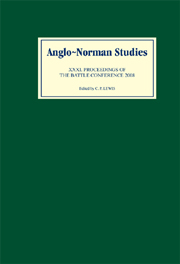Book contents
- Frontmatter
- Contents
- LIST OF ILLUSTRATIONS, MAPS, AND TABLES
- EDITOR'S PREFACE
- ABBREVIATIONS
- Kingship, Lordship, and Community in Eleventh-Century England (R. Allen Brown Memorial Lecture)
- Citadels of God: Monasteries, Violence, and the Struggle for Power in Northern England, 1135–1154
- Writing Civil War in Henry of Huntingdon's Historia Anglorum
- Land, Family, and Depredation: The Case of St Benet of Holme's Manor of Little Melton
- Brothers at Court: Urse de Abetot and Robert Dispenser
- Gerald of Wales and the Prophet Merlin
- The First Hundred Years of the Abbey of Tiron: Institutionalizing the Reform of the Forest Hermits
- All Roads Lead to Chartres: The House of Blois, the Papacy, and the Anglo-Norman Succession of 1135
- The Vita Ædwardi: The Politics of Poetry at Wilton Abbey
- William of Malmesbury, King Henry I, and the Gesta Regum Anglorum
- Twelfth-Century Receptions of a Text: Anglo-Norman Historians and Hegesippus
- LIST OF CONTENTS OF VOLUMES 1–30
All Roads Lead to Chartres: The House of Blois, the Papacy, and the Anglo-Norman Succession of 1135
Published online by Cambridge University Press: 12 September 2012
- Frontmatter
- Contents
- LIST OF ILLUSTRATIONS, MAPS, AND TABLES
- EDITOR'S PREFACE
- ABBREVIATIONS
- Kingship, Lordship, and Community in Eleventh-Century England (R. Allen Brown Memorial Lecture)
- Citadels of God: Monasteries, Violence, and the Struggle for Power in Northern England, 1135–1154
- Writing Civil War in Henry of Huntingdon's Historia Anglorum
- Land, Family, and Depredation: The Case of St Benet of Holme's Manor of Little Melton
- Brothers at Court: Urse de Abetot and Robert Dispenser
- Gerald of Wales and the Prophet Merlin
- The First Hundred Years of the Abbey of Tiron: Institutionalizing the Reform of the Forest Hermits
- All Roads Lead to Chartres: The House of Blois, the Papacy, and the Anglo-Norman Succession of 1135
- The Vita Ædwardi: The Politics of Poetry at Wilton Abbey
- William of Malmesbury, King Henry I, and the Gesta Regum Anglorum
- Twelfth-Century Receptions of a Text: Anglo-Norman Historians and Hegesippus
- LIST OF CONTENTS OF VOLUMES 1–30
Summary
When Henry I died unexpectedly at Lyons-la-Forêt in 1135, Stephen of Blois dashed across the English Channel, gained control of the royal treasury, and had himself crowned king of England by the archbishop of Canterbury in Westminster abbey on 22 December. All this he was able to do despite the fact that Archbishop William of Corbeil and the other lay and ecclesiastical magnates of the realm, including Stephen himself, had sworn solemn oaths to uphold the succession of Henry's daughter, the Empress Matilda. Even more remarkably, Stephen obtained almost immediate confirmation of his accession from Pope Innocent II, a confirmation which was repeated in 1139 when the empress's adherents appeared in Rome to present her case to the pope in person. Innocent's successors seem to have been less enthusiastic about Stephen's claim, but the next three popes all ordered that there should be ‘no innovations’ with respect to the crown of England. It has usually been assumed that the sacred nature of the coronation itself made the popes reluctant to sanction the overthrow of a consecrated monarch, despite the oaths in support of Matilda's claim and subsequent conflicts such as the arrest of the bishops in 1139, the York election dispute, and Henry of Winchester's persistent and annoying attempts to become an archbishop. This view, however, overlooks the ties of friendship and co-operation, spanning two generations, which united the house of Blois with the reform papacy.
- Type
- Chapter
- Information
- Anglo-Norman Studies 31Proceedings of the Battle Conference 2008, pp. 118 - 134Publisher: Boydell & BrewerPrint publication year: 2009



